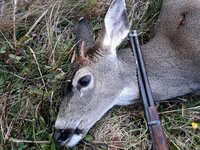- Messages
- 1,458
- Reactions
- 3,574
Andy, are they "Kentucky" rifles or are they "Pennsylvania" rifles?Thanks.
I put them on display at museums , rendezvous , shooting events , history fairs etc....
Its a hands on display...as in I will hand you a firearm or item , so we can discuss it.
Nice to talk history with an item that might have been there...or at least is from the time period.
When I do a "Plains Rifle" display a Winchester Model 94 is often a part of it....
Kinda neat to have rifles that span from the flintlock onward.
Andy












